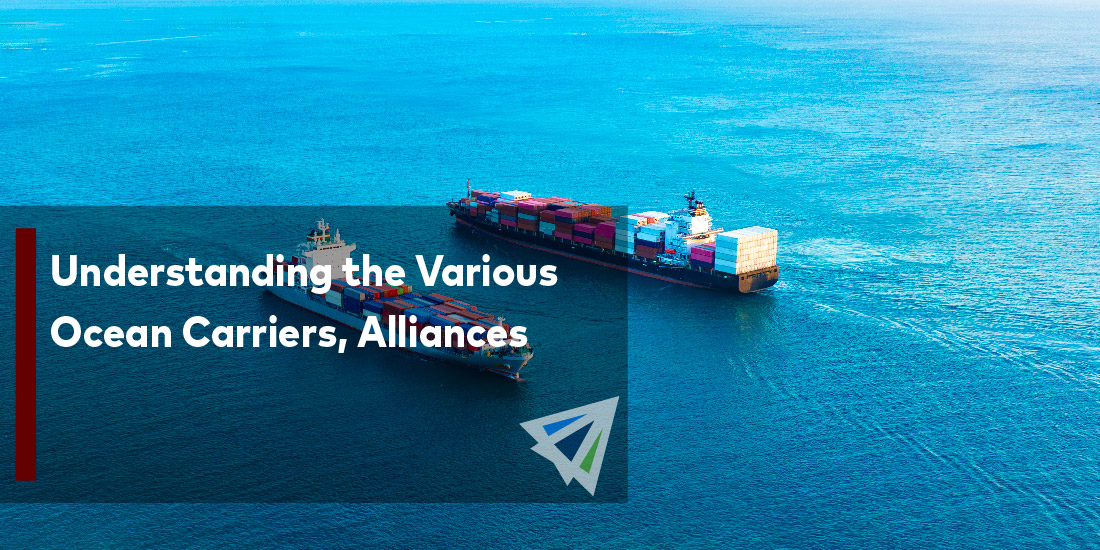Ocean carriers, the giants of global maritime logistics, play a pivotal role in facilitating international trade by transporting goods across vast distances. Their operations are often bolstered by alliances – collaborative networks formed to enhance service offerings, optimize routes, and reduce costs. Understanding these carriers and their alliances is essential for businesses seeking to streamline their supply chains and gain insights into the dynamics of global shipping.
In this blog we will explore the leading ocean carriers, examine how their alliances function, and which alliances are splitting up. Hopefully, by the end of this blog, you will achieve a better understanding of the top global ocean carriers and the carrier alliances that have formed.
Learning More About Ocean Carriers
There’s many ocean carriers in the world but in this blog we will focus on the world’s largest: Maersk, MSC, CMA CGM, Hapag-Lloyd, and ONE.
MSC
Mediterranean Shipping Company has over 800 cargo vessels and another 111 on the docket, which will allow them to have around 900 vessels. Some of their main routes include the Transpacific, Asia – Europe, and Transatlantic.
MAERSK
Maersk was established in April 1904 and became a large conglomerate with activities in shipping, terminals, logistics, oil and gas, and other offshore activities spanning more than 130 countries, with over 700 vessels. Some of their main routes include the Transpacific, Asia – Europe, Intra – Asia, and the Transatlantic.
CMA-CGM
CMA was founded in 1978 and then acquired CGM in 1996. They operate in over 160 countries with a wide fleet of 620 vessels, and serving 420 of the world’s 521 commercial ports, with 22 million TEUs transported, per their website. Some of their main routes include: Asia – Europe, Intra – Africa, Transpacific, etc.
HAPAG-LLOYD
Hapag-Lloyd was founded in 1847, they have 287 vessels, and they serve customers in over 400 locations. They also have around 114 liner services globally to create quick and reliable connections between more than 600 ports on all continents, per their website. Some of their main routes include: Intra-Americas, Transatlantic, Middle East, Latin America, etc.
ONE
This carrier was created in 2017 and provides a wide variety of coverage. As their websites documents, this carrier has a fleet size of more than 1.8 million TEUs, a fleet of over 200 vessels that are deployed to a service network that spans throughout 120 countries across the world. Some of their main routes include: Intra-Asia, Transpacific, Asia – Europe, Mediterranean, etc.
Different Alliances
Ocean alliances are strategic partnerships between major container shipping lines. Through these agreements, member lines can share vessels, coordinate port visits, and sometimes jointly operate entire trade routes. The primary aim of these alliances is to achieve cost savings, maximize efficiency, and enhance service quality.
2M Alliance
This includes Maersk and Mediterranean Shipping Company (MSC) as members, until early next year when Maersk will be leaving the Alliance, set to start a partnership of their own with Hapag-Lloyd called the Gemini Cooperation – effective February 2025. This alliance cease to exist at that point, as MSC decided (at least for now) to stick it out on their own, not expecting to join any alliances.
THE Alliance
This Alliance launched in 2016 with operations setting sail in 2017. Members of this partnership include Yang Ming, ONE, HMM, and Hapag-Lloyd, but as mentioned above Hapag-Lloyd will be leaving THE Alliance and partnering up with Maersk with the Gemini Cooperation early next year. Some of the prominent trade routes for this Alliance include Asia – North America; Asia – Europe; Europe – North America.
Ocean Alliance
Forming in 2017, this partnership includes CMA CGM, Evergreen, COSCO, and OOCL as members and was formed with the goal to reduce operational costs, optimize capacity, and improve service offerings. The Ocean Alliance also announced in early March that they would be renewing their partnership until 2032, giving members a five year extension.
[NEW] Gemini Cooperation
Starting February of next year, this partnership will comprise of Maersk and Hapag-Lloyd, both of whom have stated it will remain a two-member alliance. This Cooperation will cover a variety of global trade lanes Asia – North Europe; Asia – Mediterranean; Middle East – Europe; Middle East and India- Mediterranean; Asia – Middle East; Asia – U.S. EC and U.S. WC. They will also have a fleet pool of about 290 vessels with a combined capacity of 3.4 million TEUs; of which Maersk will be 60% of that share and Hapag-Lloyd with 40%.
Looking Ahead
In conclusion, navigating the world of ocean carriers and their alliances is important for understanding the global shipping landscape. By delving into the operations and partnerships of key players like Maersk, MSC, CMA CGM, Hapag-Lloyd, and ONE, businesses can better understand how these alliances shape trade routes and impact supply chain efficiency. As alliances evolve and new partnerships form, staying informed about these changes will help companies stay up to date in the realm of international maritime logistics.
Interlog continues to stay up to date on this and the latest in the market, to provide our customers and readers with the latest industry news. Should you have any questions regarding this, please reach out to our team today.
Additionally, we have our weekly market updates that provide relevant freight news, updates, developments across the industry, and more.
